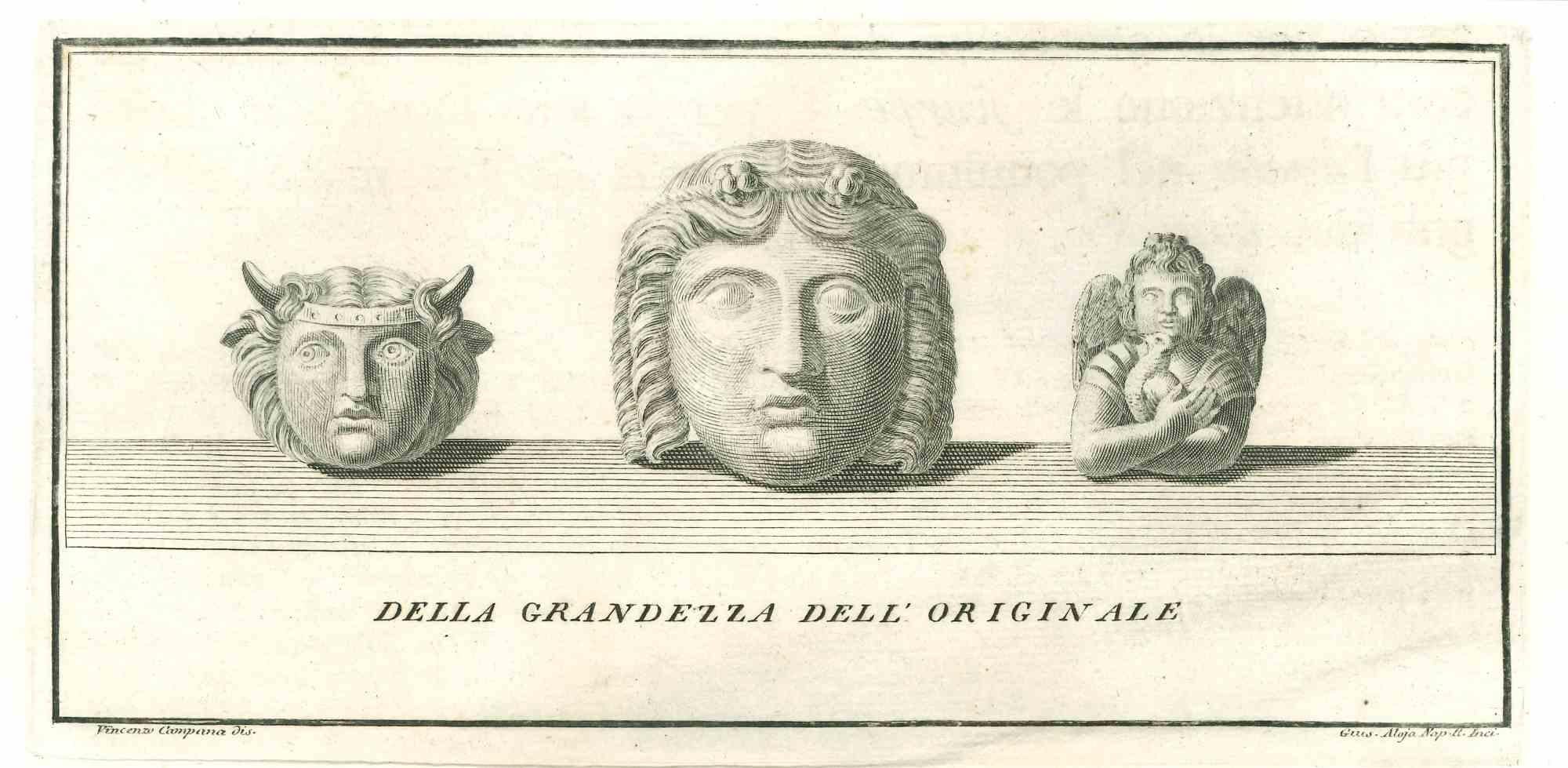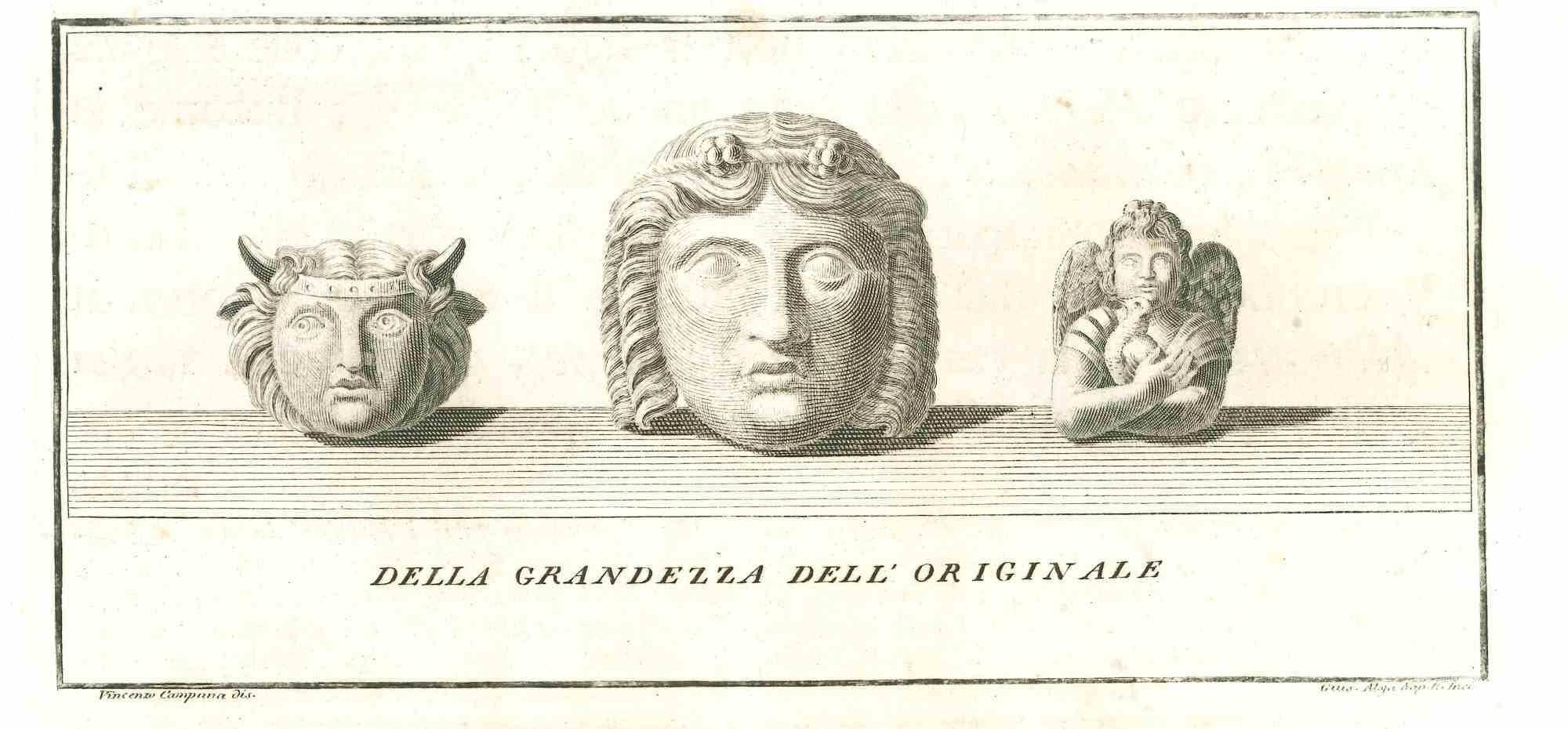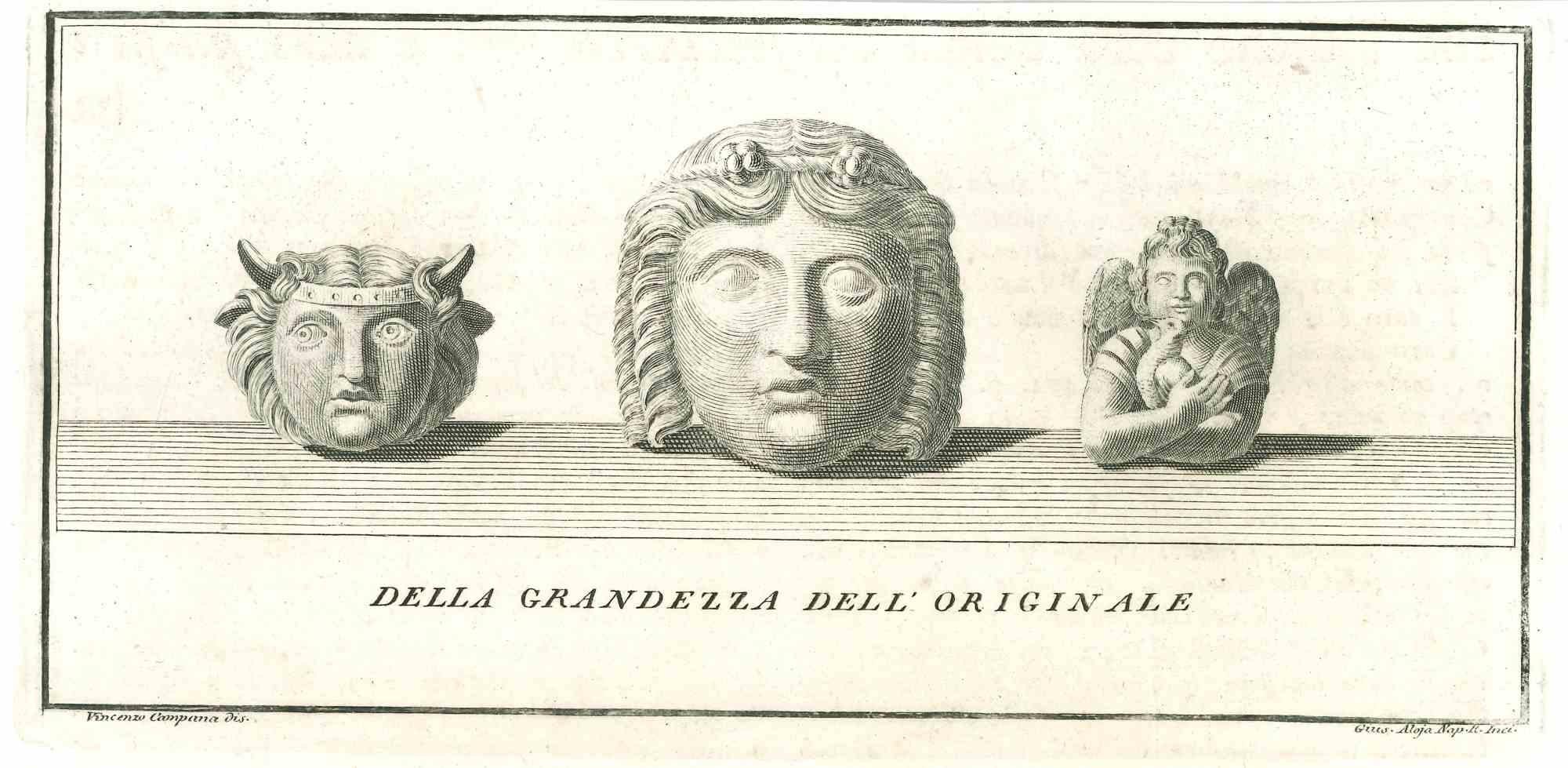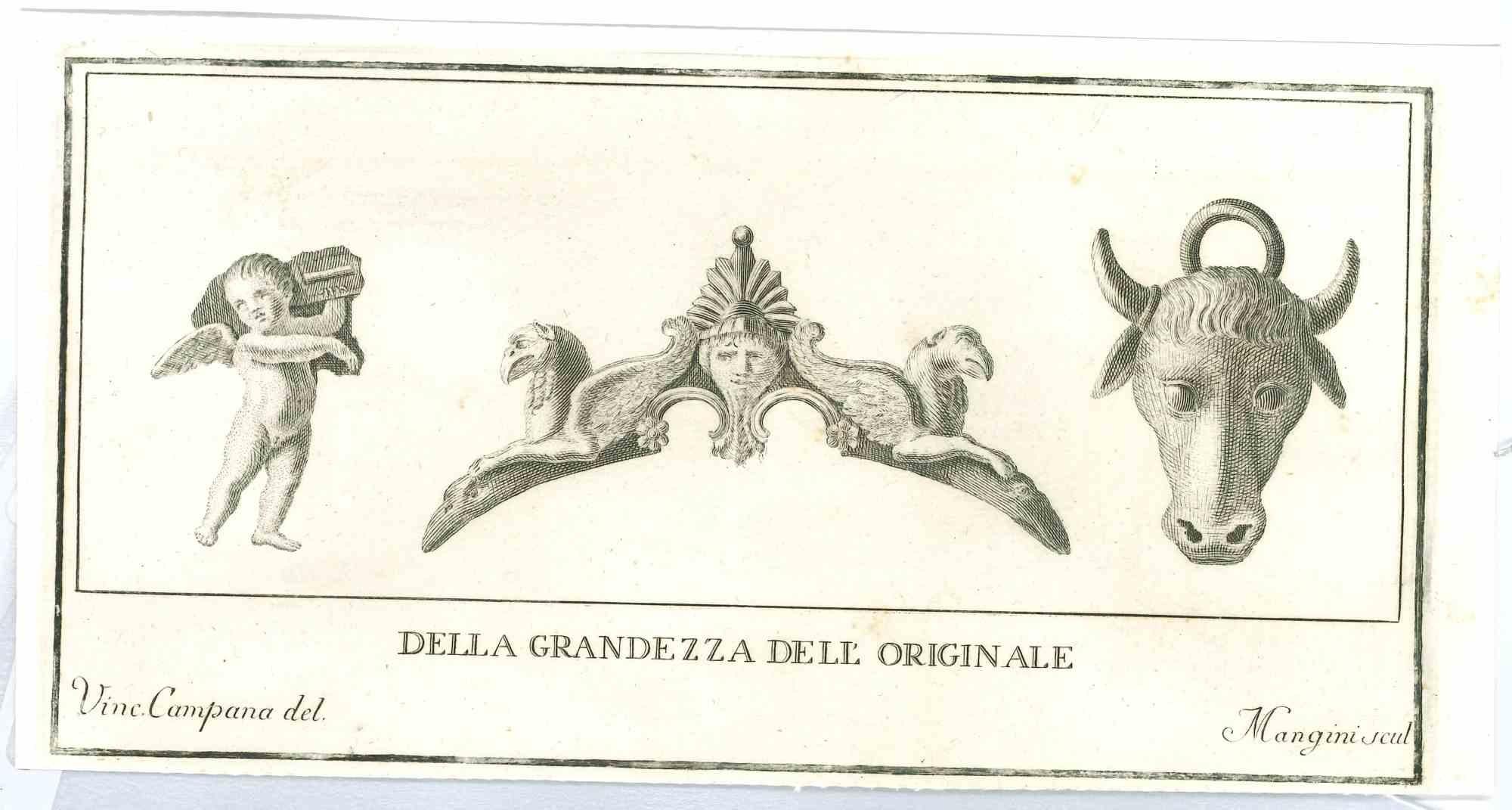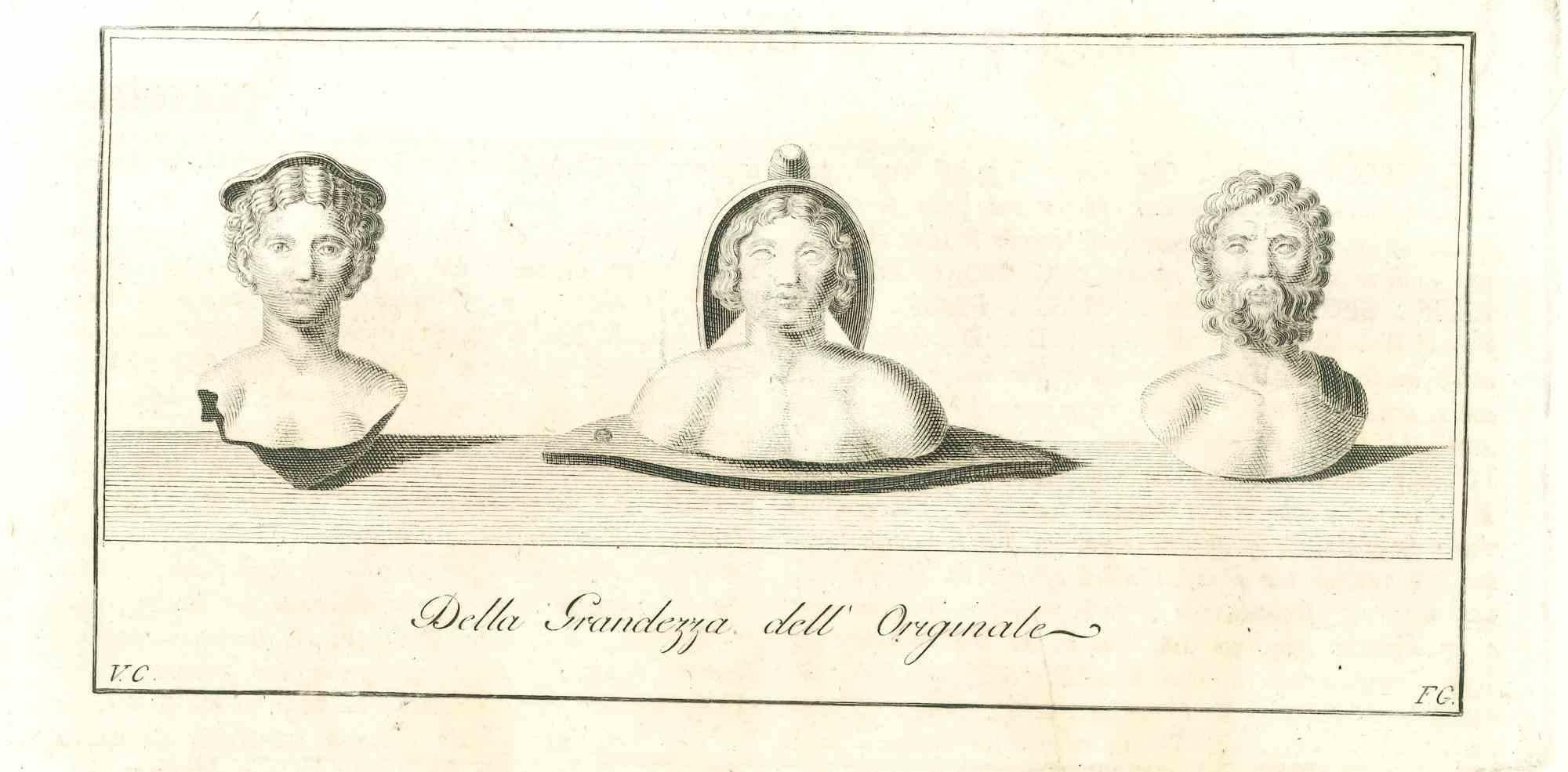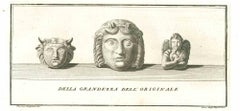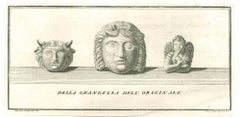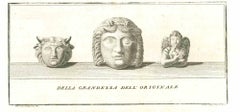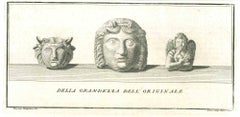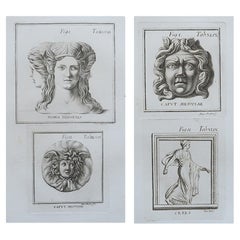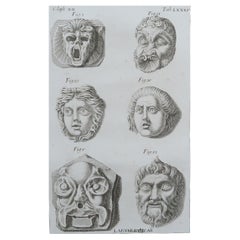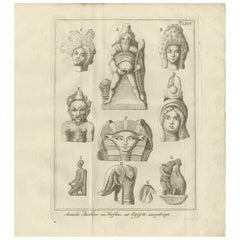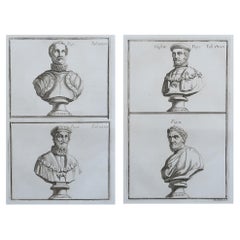Articles similaires à Anciennes têtes de protection romaines - gravure d'origine de Vincenzo Campana - XVIIIe siècle
Vous voulez plus d'images ou de vidéos ?
Demander au vendeur plus d'images ou de vidéos
1 sur 2
Vincenzo CampanaAnciennes têtes de protection romaines - gravure d'origine de Vincenzo Campana - XVIIIe siècle18th Century
18th Century
460 €TVA incluse
À propos de cet article
Ancient Roman Protecting Heads, from the series "Antiquities of Herculaneum", is an original etching on paper realized by Vincenzo Campana in the 18th century.
Signed on the plate.
Bon état.
The etching belongs to the print suite “Antiquities of Herculaneum Exposed” (original title: “Le Antichità di Ercolano Esposte”), an eight-volume volume of engravings of the finds from the excavation of the ruins of Herculaneum in the Kingdom of Naples (now Campania, Italy).
It was published between 1757 and 1792 by the Regia Stamperia, and copies were delivered to selected recipients across Europe.
Despite the title, the Antiquity of Herculaneum shows objects from all the excavations undertaken by the Bourbons in the Gulf of Naples. These include Pompeii, Stabia and two sites of Herculaneum: Resina and Portici.
The Bourbon King Carlo appointed fifteen scholars creating a new “Herculaneum Academy” to study the artifacts and publish the results of the archaeological excavations of the sites.
The engravings are of high quality and the accompanying text shows a large scholarship.
They were realized by 25 prominent artists involved by the King to prepare drawings and engravings on the finds, among which we can find Giovanni Elia Morghen, Carlo Nolli, Luigi Vanvitelli and Giovanni Battista Casanova.
The “Antiquities” was designed more to amaze readers with the quality of the objects in the collection of the King of Naples than to be used in research., following and increasing the interest of 18th century society for the classical culture and Art in particular.
Through the exaltation of the classical concept of proportions and harmony, the book was of inspiration to the neoclassical movement in Europe, giving artists and decorators access to a huge shop of Hellenistic motifs.
Ref.:
National Gallery (Washington), Mark J. Millard Architectural, IV (2000), no. 1;
L. Garcia y Garcia, Nova bibliotheca pompeiana (2 v., 1998);
Royal Institute of British Architects, British Architectural Library ... Early printed books, 1 (1994), no. 112.
U. Pannuti, 'Incisori e disegnatori della Stamperia Reale di Napoli nel secolo XVIII: la pubblicazione delle Antichità di Ercolano', in Xenia antiqua, 9 (2000), p. 151-178;
V. Trombetta, 'L'edizione de Le Antichità di Ercolano esposte' in Rendiconti dell'Accademia di Archeologia, lettere e belle arti di Napoli , 59 (1984), p.151-172.
- Créateur:
- Année de création:18th Century
- Dimensions:Hauteur : 12 cm (4,73 po)Largeur : 25 cm (9,85 po)Profondeur : 1 mm (0,04 po)
- Support:
- Mouvement et style:
- Période:
- Encadrement:Options d'encadrement disponibles
- État:Insurance may be requested by customers as additional service, contact us for more information.
- Adresse de la galerie:Roma, IT
- Numéro de référence:Vendeur : T-1251131stDibs : LU65039016842
À propos du vendeur
4,9
Vendeur Platine
Vendeurs premium dont la note est supérieure à 4,7 et le délai de réponse de 24 heures maximum
Vendeur 1stDibs depuis 2017
7 776 ventes sur 1stDibs
Temps de réponse habituel : 2 heures
- ExpéditionRecherche du devis...Expédition depuis : Grasse, France
- Politique des retours
Certaines parties de cette page ont été traduites automatiquement. 1stDibs ne garantit pas l'exactitude des traductions. L'anglais est la langue par défaut de ce site web.
Garantie d'authenticité
Bien qu'il soit peu probable que la situation se présente, dans le cas où vous rencontreriez un problème d'authenticité d'un article, contactez-nous dans un délai d'un an pour obtenir un remboursement intégral. DétailsGarantie de remboursement
Si votre article n'est pas conforme à la description, est endommagé pendant le transport ou ne vous est pas livré, contactez-nous sous 7 jours pour obtenir un remboursement intégral. DétailsAnnulation sous 24 heures
Vous disposez d'un délai de 24 heures pour annuler votre achat sans motif.Des vendeurs professionnels agréés
Nos vendeurs de renommée mondiale doivent respecter des normes strictes en matière de service et de qualité, afin de préserver l'intégrité de nos fiches produit.Garantie d'alignement des prix
Si vous constatez qu'un autre vendeur a mis en vente le même article à un prix inférieur sur un autre site, nous nous alignerons sur ce prix.Livraison en toute confiance à l'international
Notre réseau de transporteurs de premier ordre propose des options d'expédition spécialisées dans le monde entier, y compris des livraisons personnalisées.Plus d'articles de ce vendeur
Tout afficherStatues romaines anciennes - gravure originale de Vincenzo Campana - 18ème siècle
Par Vincenzo Campana
Statues romaines antiques, de la série "Antiquités d'Herculanum", est une gravure originale sur papier réalisée d'après un dessin de Vincenzo Campana au XVIIIe siècle.
Signé sur la ...
Catégorie
XVIIIe siècle, Moderne, Estampes - Figuratif
Matériaux
Eau-forte
Statue romaine antique - gravure originale de Vincenzo Aloja - 18ème siècle
Par Vincenzo Campana
Statue romaine antique, de la série "Antiquités d'Herculanum", est une gravure originale sur papier réalisée par Vincenzo Aloja au XVIIIe siècle.
Signé sur la plaque en bas à droite...
Catégorie
XVIIIe siècle, Maîtres anciens, Estampes - Figuratif
Matériaux
Eau-forte
Statue romaine antique - gravure originale de Vincenzo Aloja - 18ème siècle
Par Vincenzo Aloja
Statue romaine antique, de la série "Antiquités d'Herculanum", est une gravure originale sur papier réalisée par Vincenzo Aloja au XVIIIe siècle.
Signé sur la plaque en bas à droite...
Catégorie
XVIIIe siècle, Maîtres anciens, Estampes - Figuratif
Matériaux
Eau-forte
Statue romaine ancienne - eau-forte de Vincenzo Aloja - 18ème siècle
Par Vincenzo Aloja
Statue romaine antique, de la série "Antiquités d'Herculanum", est une gravure originale sur papier réalisée par Vincenzo Aloja au XVIIIe siècle.
Signé sur la plaque en bas à droite...
Catégorie
Fin du XVIIIe siècle, Maîtres anciens, Estampes - Figuratif
Matériaux
Eau-forte
Statues romaines anciennes - gravure originale de Vincenzo Campana - 18ème siècle
Par Vincenzo Campana
Statues romaines antiques, de la série "Antiquités d'Herculanum", est une gravure originale sur papier réalisée d'après un dessin de Vincenzo Campana au XVIIIe siècle.
Signé sur la ...
Catégorie
XVIIIe siècle, Moderne, Estampes - Figuratif
Matériaux
Eau-forte
Statues romaines anciennes - gravure originale de Vincenzo Campana - 18ème siècle
Par Vincenzo Campana
Statues romaines antiques, de la série "Antiquités d'Herculanum", est une gravure originale sur papier réalisée d'après un dessin de Vincenzo Campana au XVIIIe siècle.
Signé sur la ...
Catégorie
XVIIIe siècle, Moderne, Estampes - Figuratif
Matériaux
Eau-forte
Suggestions
Grandes estampes originales anciennes du Grand Tour - Masques. Rome, 1776
Merveilleuses images de masques romains classiques
Gravures sur cuivre
Publié par Monaldini, Rome, 1776
Papier vélin de bonne qualité
Expédition gratuite
Catégorie
Antiquités, années 1770, italien, Romain classique, Estampes
Matériaux
Plâtre
66 € / ensemble
Livraison gratuite
Grande échelle imprimé Grand Tour original - Masques grotesquesques Rome, 1776
Magnifique image de masques romains classiques
Gravures sur cuivre
Publié par Monaldini, Rome, 1776
Papier vélin de bonne qualité
Expédition gratuite
Catégorie
Antiquités, années 1770, italien, Romain classique, Estampes
Matériaux
Plâtre
35 €
Livraison gratuite
Têtes et figures anciennes égyptiennes et gréco-romaines - Gravure c.1776
Titre : Têtes et figures antiques égyptiennes et gréco-romaines - Gravure c.1776
Description :
Cette gravure antique détaillée présente un assemblage fascinant de sculptures et de t...
Catégorie
Antiquités, Fin du XVIIIe siècle, Néerlandais, Estampes
Matériaux
Papier
Grandes estampes anciennes originales de bustes de la Renaissance Rome 1776
Magnifiques images de bustes de la Renaissance
Gravures sur cuivre
Publié par Monaldini, Rome, 1776
Papier vélin de bonne qualité
Expédition gratuite
Catégorie
Antiquités, années 1770, italien, Renaissance, Estampes
Matériaux
Plâtre
66 € / ensemble
Livraison gratuite
Statues romaines anciennes au Vatican : Un ensemble de trois gravures du C.I.C.
Par Vincenzo Dolcibene
Groupement de trois gravures anciennes représentant des statues trouvées au Vatican, dont : "Pescatore" (Pêcheur), "Pastore" et "Istrione", "Gia nella Villa Mattei" (Trouvé dans la V...
Catégorie
années 1780, Maîtres anciens, Estampes - Nature morte
Matériaux
Gravure
Grandes estampes originales anciennes du Grand Tour - Statues. Rome, 1776
Merveilleuses images de statues romaines classiques - Minerva et Mercure
Gravures sur cuivre
Publié par Monaldini, Rome, 1776
Papier vélin de bonne qualité
Expédition gratuite
...
Catégorie
Antiquités, années 1770, italien, Romain classique, Estampes
Matériaux
Plâtre
66 € / ensemble
Livraison gratuite

